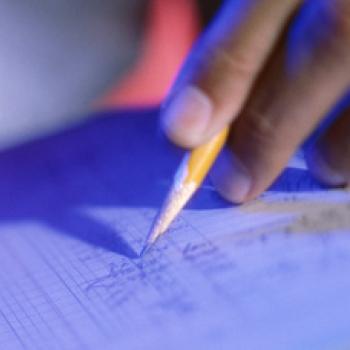Talking, Writing, and Reasoning: Making Thinking Visible with Math Journals

- Preview |
- Standards |
- Resources & Preparation |
- Instructional Plan |
- Related Resources |
- Comments
Overview
By talking, writing, and reasoning in math journals, students shift the emphasis of their work from finding the “right” answer to a metacognitive exploration of how their problem-solving works. Students begin by exploring their own attitudes and feelings about math by responding to open-ended prompts in their math journals. They are then introduced to the magic triangle puzzle and invited to talk and write about their predictions for how to solve the puzzle, drawing comparisons with prediction in reading and journal writing for language arts. Students then work in small groups to find multiple solutions to the puzzle and write their solutions, strategies, and other observations in their math journals. Next, they examine their notes from the group work and look for evidence of positive attitudes and successful problem solving. Finally, they revisit their initial journal entry and assess how and why their attitude has changed.
Featured Resources
Logistics of Mathematics Journals: Frequently Asked Questions: This teacher resource answers common questions about using math journals with students.
Getting Started with Math Journals: This teacher resources describes how to get students started with math journals, stressing the importance of using puzzles, open-ended prompts, and other questions that invite more than single right or wrong answers.
Math Journal Prompts about Attitudes and Dispositions: These open-ended prompts can be used during any part of your mathematics curriculum.
From Theory to Practice
Features that contribute to an effective community of writers also apply to mathematics classrooms, where students use writing and talking "to make their mathematical thinking visible," according to Phyllis and David Whitin (Math 2). In positive environments, children are able to take risks, share tentative ideas, build on the thoughts of others, postpone judgment, and be perseverant, even when problems arise. The National Council of Teachers of Mathematics states that to communicate mathematically, students need "to think, question, solve problems, and discuss their ideas, strategies, and solutions" (NCTM 18), and to "listen to and understand conjectures and explanations offered by [others]" (NCTM 57). Open-ended mathematical tasks, such as the Magic Triangle Puzzle, provide a challenge to all learners, but at the same time are accessible to children with a wide range of expertise ("Promoting Communication"). Engaging in collaborative problem solving and recording, and making strategies public help establish routines for using mathematics journals.
Further Reading
Common Core Standards
This resource has been aligned to the Common Core State Standards for states in which they have been adopted. If a state does not appear in the drop-down, CCSS alignments are forthcoming.
State Standards
This lesson has been aligned to standards in the following states. If a state does not appear in the drop-down, standard alignments are not currently available for that state.
NCTE/IRA National Standards for the English Language Arts
- 4. Students adjust their use of spoken, written, and visual language (e.g., conventions, style, vocabulary) to communicate effectively with a variety of audiences and for different purposes.
- 5. Students employ a wide range of strategies as they write and use different writing process elements appropriately to communicate with different audiences for a variety of purposes.
- 11. Students participate as knowledgeable, reflective, creative, and critical members of a variety of literacy communities.
- 12. Students use spoken, written, and visual language to accomplish their own purposes (e.g., for learning, enjoyment, persuasion, and the exchange of information).
Materials and Technology
Printouts
Preparation
- Make sure that students have had experience with math journals. For more information, visit the Getting Started with Math Journals handout, or for quick reference, look at the Frequently Asked Questions handout.
- Make copies of The Magic Triangle Puzzle.
- Make an overhead transparency of The Magic Triangle Puzzle.
- If needed, make copies of the Math Journal Prompts about Attitudes and Dispositions for the students.
- Gather related children's books selected from the booklist.
- Test the Graphic Map on your computers to familiarize yourself with the tools and ensure that you have the Flash plug-in installed. You can download the plug-in from the technical support page.
Student Objectives
Students will
- describe and illustrate an example of their own attitudes or dispositions that contribute to problem solving.
- arrange the numbers 1–6 in a triangular formation so that the three numbers on each side equal the same sum.
- explain a problem-solving strategy to a peer audience using writing, using talking, and using visual representation.
Session One: Writing about Math
- As a warm-up activity, invite students to explore their thoughts about math in their Math Journals, in order to encourage students to think about their attitudes and dispositions (i.e., their mood or temperament) about math.
- Consult the Math Prompts handout for ideas on writing about math.
- Once students have completed writing their thoughts about math, invite them to share their journal entries with the whole class, in small groups, or in pairs (as a "pair and share" activity).
- As an extension, students can use the Graphic Map to illustrate their attitudes and dispositions about a particular math topic or math throughout their school careers.
- If there is time left in the session, share a book from the booklist that shows math in a positive light.
Session Two: The Magic Triangle
- Present the Magic Triangle Puzzle using an overhead transparency, and explain that the object of the puzzle is to arrange the numbers in the six circles on the triangle so that the sums of all sides are equal.
- Demonstrate by randomly placing the numbers in the circles.
- Invite students to test your solution. (Be sure that students understand that numbers in the vertices are used twice.)
- When two different sums are found, ask students to think about how they might move the numerals to solve the puzzle. If desired, students might "pair and share" about their ideas.
- As opportunities allow, draw parallels between the work students do in reading/writing workshop and their writing in mathematics:
- Like predictions in reading, predictions in mathematics generate possibilities to test out as students continue working.
- Oral suggestions are the seeds for writing in mathematics journals. In mathematics, students can "talk on paper" as they do in their writers' notebooks.
- Like predictions in reading, predictions in mathematics generate possibilities to test out as students continue working.
- As students discuss the Magic Triangle, write a few of their ideas on the board.
- Have students make a plan, and record it in their journals. Although they may use an idea from the board, they are not limited to this list.
- Distribute copies of the Magic Triangle Puzzle, have students cut out or tear apart the numbers and try to solve the puzzle. Before they begin, have a volunteer restate the problem. Note that even if students are familiar with the puzzle, there are many patterns to discover.
- Explain the questions at the bottom of the puzzle and encourage students to record any solution that they find. They do not need to answer all of the questions; they may choose from the list.
- As students work, circulate among the groups and jot down samples of their comments and conversations. Encourage students to write down these words as well. Be sure to capture instances of the following:
- Tentative language (These example comments relate to Prompt #1):
- "I'm not sure"
- "maybe"
- "I'm wondering if"
- "it doesn't seem so"
- Hypotheses/conjectures (Prompt #1; if successful, Prompt #4):
- "Small numbers need to be in the corners"
- "It has to be all odd on a side"
- Collaboration (Prompt #4):
- "Let's try"
- "You gave me an idea"
- Surprise (Prompts # 2, 3):
- "Hey! There's another solution!"
- "You put big numbers in the corners and it worked? I thought it had to be small numbers."
- Other attitudes (Prompts #1 and #4):
- "Let's try another way"
- "I'm getting frustrated"
- "What would happen if we could use a zero?"
- Tentative language (These example comments relate to Prompt #1):
- In the event that some students generate all four solutions quickly, suggest that they study the solutions for patterns and relationships, or that they try changing the parameters of the problem (e.g., using negative numbers, using a set of even numbers, etc.) and try the new problem. Using Prompts #2 and #4, they can also defend in writing their reasoning for their claim that they have exhausted all possible solutions.
- After about 10 minutes, hold a brief in-process meeting in order to give students wide access to one another's thinking, to support children who are having difficulty, and to challenge all of the children to probe for patterns and relationships. Begin by asking, "What have you discovered so far?"
- Allow students to note the sum of more than one solution (e.g., 9 and 12), but do not actually show the placement of the numerals. Instead, do a think aloud, such as, "Hmmm. You have two different solutions. Are you sure that they both work? I wonder if there are other solutions? Why would more than one solution work?"
- In addition, ask a volunteer or two to describe a problem-solving strategy, such as "I needed to switch a low number to a corner to balance a high number."
- Provide a few minutes for students to write and draw, and then continue the work session.
- Have students continue to work on solutions to the puzzle for 10 minutes; then, draw their attention once more to the questions at the bottom of the handout, reminding them of the connections between their oral comments and writing.
- Allow 5 minutes for writing and drawing.
- If the students need more guidance in their writing, share the Math Journal Writing about Problem-Solving with them.
- Lead students in a discussion and demonstration of their solutions and strategies.
- After each student shares, have the speaker call on two classmates for comments and "appreciations." Appreciations can relate to their method of representation (e.g., arrows), their solution strategy, or a pattern or relationship that was noticed. Record students' comments on a chart, which you'll use in the next session.
- Use the observational notes to supplement the children's comments. For example, note how students build upon one another's ideas (collaboration), persevered, thought flexibly, and so forth.
- At the close of the discussion, allow 3 or 4 more minutes for students to add to their written commentaries. Ask students to note instances when a classmate's comment or strategy helped them solve the problem or discover a pattern, or examples of how they "didn't give up," etc.
Session Three: Problem-Solving
- Display the chart of samples of students' oral and written comments from Session Two.
- Using "pair and share," invite students to discuss the following question: "What positive attitudes for successful problem solving do our comments show?"
- Using the student's own language, make a list on another piece of chart paper. For example, students might say, "Work as a team," or "Piggyback on another person's idea," rather than, "collaborate." Point out clusters of comments that imply important attitudes that students omit.
- When the list is complete, have students develop an appropriate title for their class chart.
- Have students select one or more of the attitudes. Ask them to write and illustrate a way that their work on the Magic Triangle demonstrated this attitude.
- Allow time for students to share their writings about their thoughts and attitudes.
- After students have shared their thoughts about solving the Magic Triangle Puzzle, ask them to revisit their initial journal writing. Invite students to write about how and why their attitudes have changed or stayed the same throughout this experience.
- If there is time, students can create an additional Graphic Map, illustrating the process they followed while solving the Magic Triangle.
- End this study by reading another book from the booklist that promotes math and positive mathematical thinking.
Extensions
- Post the chart about attitudes, continuing to add to the list over time. Refer to the chart often during any work sessions (math, science, writing workshop), and for self-assessment and reflection on the nature of the classroom community.
- You may want to give some examples from professional mathematicians and scientists who showed curiosity, viewed a problem from multiple perspectives, or persevered even when they encountered difficulty. Stress commonalities between students' attitudes and those of professionals.
- Place extra copies of the Magic Triangle Puzzle in the math center. Invite students to pursue other patterns and extensions (other numbers, including negative numbers, fractions, and so on). If students have not discovered the "inner triangle" pattern, introduce this relationship as an example. Make a display of their discoveries. Create a title for the display that conveys positive attitudes and dispositions, such as "Mathematical Detectives at Work" or "Pattern Hunters."
- Allow time for students to explore puzzles and games found in students' books. Invite students to publish their discoveries. Share some children's literature from the booklist that talks more about different types of math puzzles.
- During writing workshop, allow time for students to revise and edit their descriptions of their strategies and discoveries. All students may be involved, or a small group of volunteers might consolidate the class's experiences. Publish via paper (e.g., a hall display) or a PowerPoint slide show (for parents, visitors, or another class).
- Invite students to engage family members in exploring the puzzle as part of a Family Literacy/Mathematics Night
- Invite students to explore other math puzzles from the following Websites:
Number Puzzles
Magic Triangle
Tangram Puzzles
Pentominoes
Student Assessment / Reflections
- Keep anecdotal notes about your observations and review of math journals. Save a photocopy of a sample journal entry every two to four weeks to use for comparison and evidence of growth or need for instructional support.
- Observe as students compose: What are they struggling with? What is getting easier? Are they using suggestions from you and other students? Are they excited about writing about their problem solving efforts?
- Assess the Math Journals, as discussed in the Getting Started with Math Journals handout or the Frequently Asked Questions handout.
- Conference with the students about their writing about their attitudes and dispositions, and examine their Graphic Map. Have they made progress throughout the lessons? What do they still need help with?


Add new comment